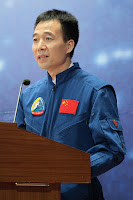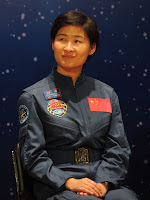06-005
The first lecture from space
As a Chinese myself, I feel
proud to have our own space stations. Back in 2013, when I saw our taikonaut
Wang Yaping hosted our first ever space lecture inside Tiangong-1 Space Lab, I
was overjoyed. I was even more excited to see further space lectures being organized
in the newer and more spacious Tiangong Space Station in these couple of years.
I am not dumb. I know that many consider
China’s space programme as a threat. Comments from haters are still on YouTube.
No, the Chinese government has not removed those comments. I read them all. I
just do not agree on their point of view. Space is too big for nations to compete with each other. I believe all
space travelers are heroes, no matter they are a cosmonaut, a astronaut, a
taikonaut, or even a billionaire the spent millions for a seat on the Blue
Origin. I sincerely wish every success of the India space program and hope that very soon
we can see the first Indian astronaut on board their Gaganyaan spacecraft.
Back to the topic, at the time when Wang Yaping was
hosting the space lecture on Tiangong-1, there was a piece of information that drew
my curiosity. Wang kept saying that she is only the second space lecturer. The
first is a NASA astronaut. Her name is Barbara Morgan.
China did not take Barbara's credit
and claimed the Tiangong-1 lecture as the first space lecture in the world. A newsclip from the Chinese government official news agent, the China Daily,
gives full credit and honor to Barbara Morgan. Wang, in her letter to Morgan,
also shows her gratitude and full respect to her.
Being overjoyed with the first
Tiangong lecture, I feel shame that I have not heard of Barbara Morgan. When did the lecture happen? What
she has done in her lecture? Presumably, the lecture should be awfully expensive
to organize. Is it available to watch on the internet? If so, I definitely would be
interested to “attend” her lecture together with my kids. I googled, and found
that there is actually quite a story behind Barbara Morgan.
The story of Barbara Morgan
The story began in 1984 when the former president of United States, Ronald Reagan, announced a NASA program called “Teacher
in Space Project (TISP)”. The aim of the program is to inspire students, honor
teachers, and spur interest in mathematics, science, and space exploration. The
project would carry teachers into space as Payload Specialists (non-astronaut
civilians), who would return to their classrooms to share the experience with
their students. Christa McAuliffe was chosen for the program and Barbara Morgan
was her backup. On January 28, 1986, Christa was on board the Space Shuttle
Challenger to ISS. Unfortunately, the space shuttle blew up during the take off and Christa died
in the disaster. TISP was cancelled later on.
Years later, a successor program
to TISP, Educator Astronaut Project, was created and Barbara joined the mission
STS-118 and finally made her way to the ISS in 2007, some 21 years after the
Challenger disaster. So, Barbara’s “space lecture” is a mixture of joy and
sadness.
About Morgan’s “space lecture”
Compare to China’s hour-long Tiangong Space Lecture, Morgan’s “space lecture” is more a combination of several Q&A sessions, carried out on different days to different groups of students. I checked the log files of the NASA mission and summarized all the Q&A sessions as below.
From STS-118 MCC Status
Report #13 (2007-8-14)
Then Morgan was joined by Anderson and mission specialists Dave Williams and Alvin Drew for the first of the mission’s three educational events. Twenty children at the Discovery Center in Boise, Idaho, were given the chance to ask questions on topics ranging from how fast one could throw a baseball in space to how being a teacher is like being an astronaut. The remaining two education events are planned for Thursday and Sunday.
Below is the video recording of the Q&A session with children from Boise, Idaho. The videos were uploaded in 2007. At that time, YouTube only allows a video length with a maximum of 10 minutes. So the Q&A session is separated into 2 parts. The resolution is not even up to NTSC quality.
From STS-118 MCC Status
Report #16 (2007-8-16)
Morgan and Drew will speak with
the Challenger Center for Space Science Education in Alexandria, Va., and
children from the area at 7:06 a.m.
From STS-118 MCC Status
Report #17 (2007-8-16)
Also today, mission specialists Barbara R. Morgan and Alvin Drew answered questions from students at the Challenger Center for Space Science Education in Alexandria, Va. …
Below is the video recording of the Q&A session with students at the Challenger Center. Again, the clip is separated into 3 parts because of the length restriction of YouTube at the time of uploading.
Morgan also answered questions via an amateur radio connection from students in her former school district, McCall-Donnelly in Idaho. Morgan taught at McCall-Donnelly Elementary School from 1975-1978, and again in 1979-1998.
No
video was found but a podcast of the Q&A session is available on NASA’s website.
The transmission was carried out through FM ham radio on ISS. Please bear with the
sound quality.
From STS-118 MCC Status
Report #24 (2007-8-20)
At 10:46 a.m. Kelly, Williams and
Morgan will take a break to talk with Canadian schoolchildren from the La
Ronge, Saskatchewan area.
From STS-118 MCC Status
Report #25 (2007-8-20)
Kelly and Morgan also joined Williams for a Canadian Space Agency educational event with children from Williams' home province, Saskatchewan, in Canada. The astronauts fielded questions from seventh and eighth graders on subjects ranging from whether astronauts grow in space, how microgravity affects bone density and what you need to know to operate the Canadarm.
Below
is the video recording of the Q&A session with students from Saskatchewan,
Canada. Sorry that these video clips are the best I can find.
Hope you have enjoyed the “lectures”.
Go back to the Lobby ...






























